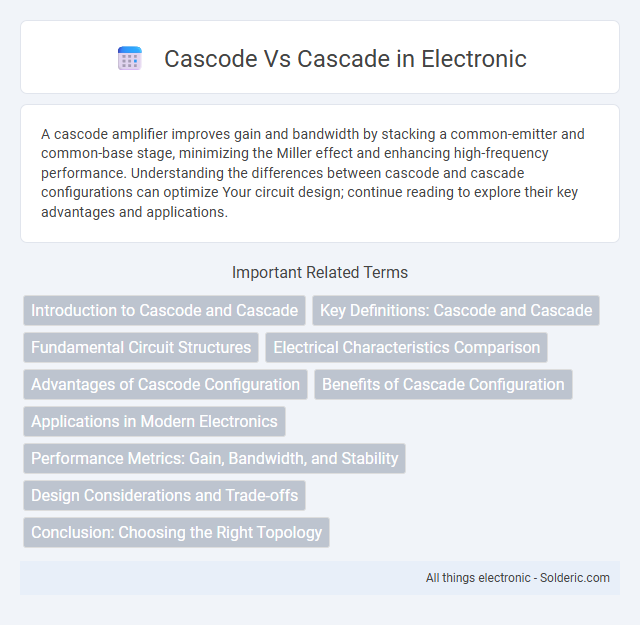A cascode amplifier improves gain and bandwidth by stacking a common-emitter and common-base stage, minimizing the Miller effect and enhancing high-frequency performance. Understanding the differences between cascode and cascade configurations can optimize Your circuit design; continue reading to explore their key advantages and applications.
Comparison Table
| Aspect | Cascode | Cascade |
|---|---|---|
| Definition | Two transistors stacked with one common source and one common gate to improve gain and bandwidth. | Two or more amplifier stages connected in series to increase overall gain. |
| Purpose | Enhances gain, bandwidth, and reduces Miller effect. | Increases total voltage gain by cascading stages. |
| Configuration | Common-source stage followed by a common-gate stage. | Multiple amplifiers connected output to input sequentially. |
| Gain | Moderate gain with improved frequency response. | Higher total gain by multiplying individual stage gains. |
| Bandwidth | Wide bandwidth due to reduced Miller capacitance. | Bandwidth usually decreases due to cascading effects. |
| Noise performance | Low noise, suitable for RF applications. | Noise accumulates across stages. |
| Complexity | More complex biasing and layout. | Simple stage-to-stage connection. |
| Applications | RF amplifiers, low-noise amplifiers. | General purpose amplifiers, audio, and signal conditioning. |
Introduction to Cascode and Cascade
Cascode and cascade are fundamental amplifier configurations in analog circuit design, each serving distinct purposes. The cascode amplifier combines a common-emitter stage with a common-base stage to enhance gain, bandwidth, and reduce Miller effect, making it ideal for high-frequency applications. In contrast, the cascade configuration involves connecting two or more amplifier stages in series to increase overall voltage gain while maintaining impedance matching between stages.
Key Definitions: Cascode and Cascade
The cascode configuration combines a common-emitter stage feeding into a common-base stage, optimizing high-frequency gain and reducing Miller effect, commonly used in RF amplifiers. Cascade refers to two or more amplifier stages connected in series to boost overall gain, often employed in multi-stage amplification systems. Understanding these key definitions helps you select the right design for applications requiring high gain versus frequency performance.
Fundamental Circuit Structures
Cascode and cascade are fundamental circuit structures used to improve amplifier performance. The cascode configuration combines a common-emitter stage with a common-base stage, enhancing bandwidth and gain by minimizing Miller effect capacitance. In contrast, the cascade structure typically connects multiple amplifier stages in series to increase overall gain without specifically addressing high-frequency limitations.
Electrical Characteristics Comparison
Cascode circuits provide higher gain-bandwidth product and improved frequency response compared to cascade configurations due to their lower Miller effect and reduced parasitic capacitances. Cascade stages tend to have simpler design and better linearity but lower overall gain and bandwidth when compared to cascode amplifiers. Your choice between cascode and cascade should balance the trade-off between speed and gain versus design complexity and linearity.
Advantages of Cascode Configuration
Cascode configuration offers higher gain and improved bandwidth compared to cascade stages by minimizing the Miller effect and enhancing frequency response. It provides better isolation between input and output, reducing parasitic capacitances and improving stability in high-frequency applications. This configuration also exhibits lower noise and increased output impedance, making it ideal for RF amplifiers and sensitive analog circuits.
Benefits of Cascade Configuration
Cascade configuration offers increased overall voltage gain and improved bandwidth by connecting multiple amplifier stages in series. This setup enhances signal amplification while maintaining stability and reducing distortion, resulting in clearer and more accurate output. Your circuits benefit from greater flexibility in design and easier gain control compared to a single-stage amplifier.
Applications in Modern Electronics
Cascode configurations excel in high-frequency applications such as RF amplifiers and low-noise receiver front ends due to their superior bandwidth and reduced Miller effect. Cascade amplifiers find common use in audio amplification and analog signal processing where moderate gain and stability are essential. Your choice between cascode and cascade topologies depends on the specific frequency response, noise performance, and linearity requirements of your electronic design.
Performance Metrics: Gain, Bandwidth, and Stability
Cascode amplifiers provide higher gain and improved bandwidth compared to cascade configurations by minimizing Miller effect capacitance, enhancing frequency response and stability. Cascade amplifiers offer moderate gain but often suffer from reduced bandwidth and potential instability due to cumulative phase shifts. Your choice should consider that cascode structures deliver better overall performance metrics, making them ideal for high-frequency applications requiring stable gain and wide bandwidth.
Design Considerations and Trade-offs
Cascode topology offers higher gain-bandwidth product and better input-output isolation compared to cascade configurations, making it ideal for high-frequency amplifier design. Cascade designs provide increased overall gain by simply stacking stages but often suffer from higher noise and reduced bandwidth due to accumulated loading effects. When choosing your amplifier architecture, weigh cascode's improved linearity and speed against cascade's simpler implementation and flexibility to meet specific performance goals.
Conclusion: Choosing the Right Topology
Cascode topology offers superior gain stability and higher bandwidth with reduced Miller effect, making it ideal for high-frequency and low-noise applications. Cascade configuration provides increased overall gain by stacking multiple amplifier stages but may suffer from larger input-output capacitance and noise accumulation. Selecting the right topology depends on the specific circuit requirements such as frequency response, noise tolerance, and gain objectives.
Cascode vs Cascade Infographic

 solderic.com
solderic.com